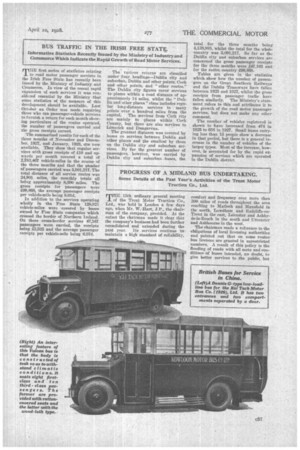BUS TRAFFIC IN THE IRISH FREE STATE.
Page 59

If you've noticed an error in this article please click here to report it so we can fix it.
Informative Statistics Recently Issued by the Ministry of Industry and Commerce Which Indicate the Rapid Growth of Road Motor Services.
TlIE first series of statfsties relating to road motor passenger services in the Irish Free State has recently been issued by the Ministry of Industry and Commerce. In view of the recent rapid expansion of such services it was considered essential by the Ministry that some statistics of the measure of this development should be available. Last October an Order was made requiring those who ran passenger-vehicle services to furnish a return for each month showing particulars of the routes operated, the number of passengers carried and the gross receipts earned.
The summarized results for each of the three months of November and December, 1927, and January, 1928, are now available. They show that regular Fiervices with gross receipts of £10 and upwards per month covered a total of 2,783,467 vehicle-miles in the courseof the three months and that the ntmber of passengers carried was 5,091,217. The total distance of all service routes was 24,901 miles, the monthly totals all being approximately 8,300 miles. The gross receipts for passengers were £99,868, the average passenger receipts per vehicle-mile being 8.61d.
In addition to the services operating wholly in the Free State 128,821 vehicle-miles were covered by buses owned by Free State companies which crossed the bordar of Northern Ireland. On these cross-border services 47,167 passengers were carried, the receipts being £3,525 and the average passenger receipts per vehicle-mile being 6.57d.
The various returns are classifies' under four headings—Dublin city and suburban, Dublin and other points, Cork and other points, and " other routes," The Dublin city figures cover services to placeS within a road distance of approximately 14 miles, whilst the "Dublin and other places" class includes regular long-distance services to many Points over a hundred miles from the capital. The services from Cork city are mainly to places within Cork County, but there 'are also services to Limerick and Dungarvan.
The greatest distance was covered by buses on services between Dublin and other places and the smallest by those on the Dublin city and suburban services. Ey far the greatest number of passengers, however, was carried by Dublin city and •suburban buses, the total for the three months being 4,138,888, whilst the total for the whole Country was 5,091,217. So far as the Dublin city and suburban services are concerned the gross passenger receipts for the three months were £47,103 and for the entire country £99,868.
Tables are given in the statistics which show how the number of passengers on the Great Southern Railways and the Dublin Tramways have fallen between 1925 and 1927, whilst the gross receipts from passenger traffic have fallen similarly. The Ministry's statement refers to this and attributes it to the growth of the road motor passenger services, but does not make any other comment.
The number of vehicles registered is shown to have increased from 474 in 1925 to 658 in 1927. Small buses carrying less than 15 people show a decrease in that period, but there is a general increase in the number of vehicles of the larger types. Most of the increase, however, is accounted for by the rapid expansion of services which are operated in the Dublin district.












































































































